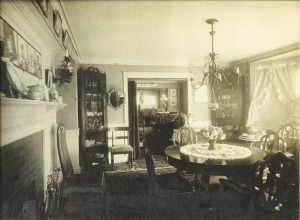Dorchester Illustration of the Day no. 1558
Today we have another interior shot from 13 Carruth Street—a photo of the dining room about 1900. The Bethmann family had quite an obsession with framed pictures.
Readers’s Comments about yesterday’s photo of the living room—
Margery Buckingham: As the owners of 13 Carruth Street from 1986 to 2002, we have been delighted (and amazed) to see these early photographs of the house. The real shock has been seeing the transformation of the roofline from gambrel to saltbox. We were aware, from the presence of a stone wall in the cellar, that the sunroom had not always been enclosed, but we thought that it had originally been an open porch. As for the interior view of the living hall, the first impression is of the sheer density of the decor. Then one notices the consistent use of early American style furnishings, whether antique or reproduction, in the rooms. The presence of large fireplace, complete with a crane for a kettle, in the dining room also testifies to the Colonial Revival enthusiasm of the Bethmanns. At a later date, the openings from the hall to the dining room and parlor were fitted with French doors.a large fireplace, complete with a crane for a kettle, in the dining room also testifies to the Colonial Revival enthusiasm of the Bethmanns. At a later date, the openings from the hall to the dining room and the parlor were fitted with French doors.a large fireplace, complete with a crane for a kettle, in the dining room also testifies to the Colonial Revival enthusiasm of the Bethmanns. At a later date, the openings from the hall to the dining room and the parlor were fitted with French doors.a large fireplace, complete with a crane for a kettle, in the dining room also testifies to the Colonial Revival enthusiasm of the Bethmanns. At a later date, the openings from the hall to the dining room and the parlor were fitted with French doors.
Anthony Sammarco lived at 13 Carruth Street before the Buckinghams: This photo shows the piano in the “Living Hall” of the house. The cabinets to the left (unseen) had musical instruments in plaster on the cabinet doors, so I always assumed it was used as a musical room. Our piano was in the room to the far right, a small parlor. The portier roads [what is a portier road? Earl asks] were used as late as 1990, and helped tremendously. I like the banjo clock between the stairhall and parlor openings, but mine was in the dining room.
Doug Wynne: Thanks for another fascinating look at how people lived in earlier times. I am especially taken by the tall lamp on top of the piano (? – another keyboard instrument to have vetted by brother Ed). Given the lack of evidence of electricity elsewhere in the picture, and given the thickness of the tube leading to it, I wonder if it might be a “portable” gas light? Yet I can almost convince myself that there are electric pull-chains hanging beneath the shade, although I seem to remember seeing gas valves so controlled. The shade itself might be a Pairpoint puffy, although I’d need to hit the reference books to confirm its overall shape. And who might the shy young lady be, peeking around the drapes. Maybe she’s trying to get her little white dog (sitting in front of the corner chair that is not in a corner) out of the picture? The twin to the banjo clock was on Antiques Road Show recently. From this distance, it looks to have the identical set of reverse-painted glass panels. The ARS item was a Willard, which were made locally, and I have read that the cases and glass were sometimes contracted out. Was there a decorating rule in those days that no two picture or photo frames in any given room could match? Thanks again for this picture.
______
The Dorchester Illustration of the Day (DIOTD) is sent weekdays. If you receive this e-mail by mistake, please reply to be taken off the e-mail list. If you know others who would like to receive the daily e-mail, please encourage them to join the group by going to http://groups.google.com/group/dorchester-historical-society. You may contact Earl Taylor at ERMMWWT@aol.com
If you value receiving the DIOTD, please express your appreciation by making a donation to the Dorchester Historical Society, either by regular mail at 195 Boston Street, Dorchester, MA 02125, or through the website at www.DorchesterHistoricalSociety.org

